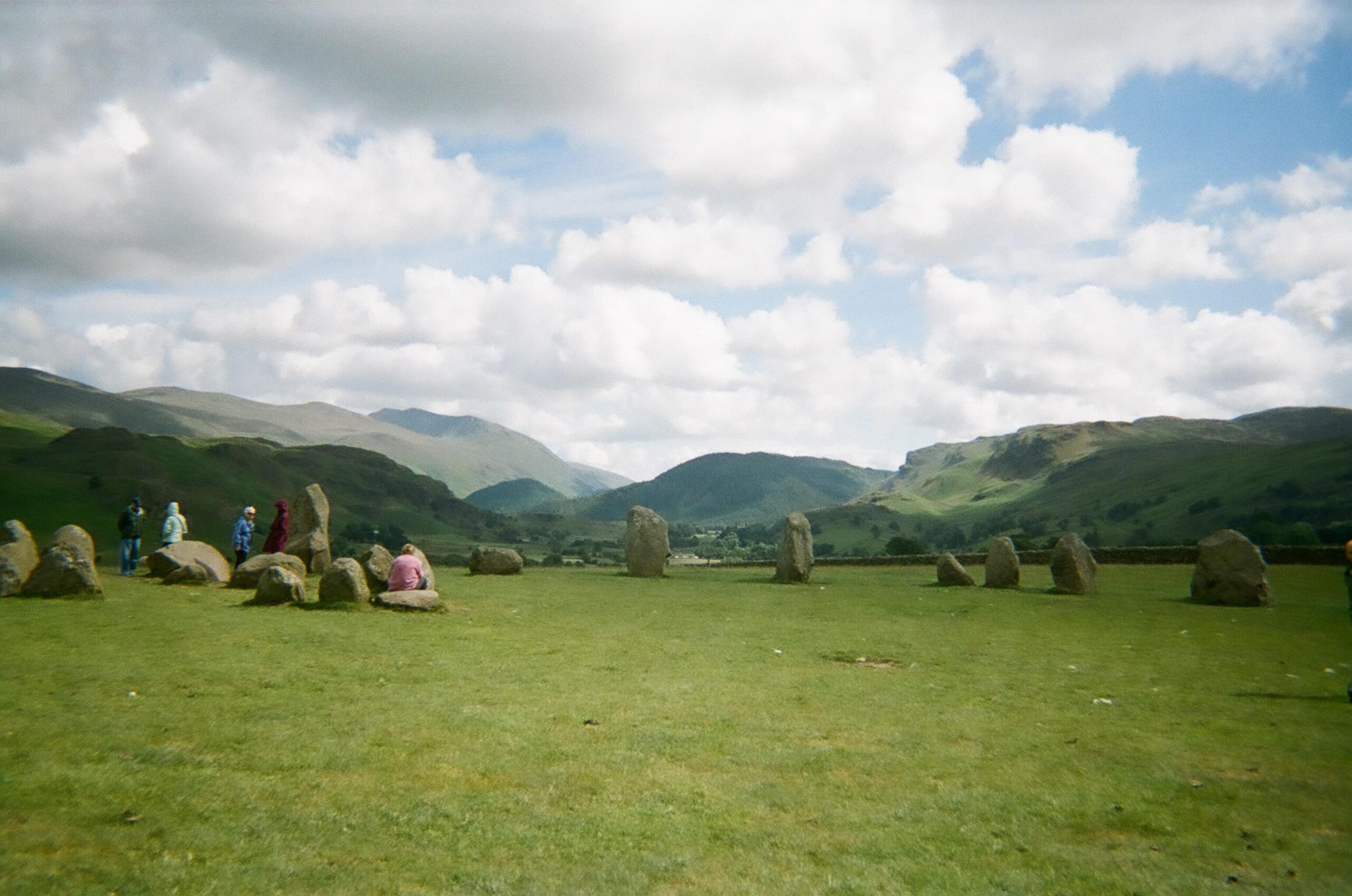Castlerigg Stone Circle

The tour bus could barely make it up the winding hill in what our hosts called the “green toothpaste tube” of the country lanes in the Lake District of north-west England. There was only enough room for one vehicle this size, and we met a red car coming down the hill, which had to pull into the grassy ditch to let us pass. The driver got out and stomped around in the tall sward to make certain he would not fall into a deep ravine, hidden beneath. There were occasionally bulges of road to pull off into, but these were far between.
There was no deep ditch, and we were able to make it through.
Like all the sacred sites our St. Olaf College “Study Travel” group visited that June, you couldn’t see the place until you were right on it, there on a flattened promontory high up in the rugged landscape. There stood the remains of a stone circle—not as massive or orderly as Stonehenge, but one you could experience fully.
Castlerigg Stone Circle is one of the oldest in the British Isles, built some 5,000 years ago in the Neolithic period, earlier than when the current arrangement of Stonehenge was made. It overlooks the Thirlmere Valley, with a view of High Seat and Helvellyn mountains in the background. Puff clouds lazily floated overhead, sliding up and down the wilderness, bumpy landscape, casting us by turns into shadow and light.
“They say it makes the land look as if she breathes.” Jonathan Hill, an English professor and one of our guides who grew up in this country, spoke with reverence beside my shoulder. I had not heard him step beside me, for I was so focused on taking in the wonder of the place.
“Yes. It looks like that.” The sun was warm but the breeze was cold, like April or May can be back home.
Down in the town of Hawkshead, there were plenty of aged trees casting shade, but up here, they had thinned out to nothing but sheep-cropped grasses and pointed, gray rocks. Sandy-gray were the color of these stones, encrusted with blotches of green and yellow lichen. Some were short and round, others taller and flatter on one side than the other, some of them leaning. Yet as I stepped between them, I felt a tingle up my spine from the ancient sacredness of this space.
These stone circles have so many myths and legends around them, for there are many unanswered questions about why they were built and how they were used. Some folklore states that the exact number of stones cannot be counted the same twice. The standing rocks reminded me of teeth, like a great mouth opened towards the sky. I sat down on one, feeling the texture of the surface and its connection with the earth.
There was no museum, no audio tour, nothing but the quiet of this place and the few people walking around. I sang one of my favorite Loreena McKennitt songs, watching the sky and the land. Some kind of gift needed to be offered during a visit to this place. It has meant something very special to the people of this region for a long time.
I remember seeing a documentary once. I wish I remembered the name of it (I really enjoy documentaries and have seen untold scores of them over the years). It was looking at the sacred sites of the British Isles over time. The oldest were in mounds, womb-like, in the earth (think Old and New Grange in Ireland). Then these were sealed up, and the structures after that were in the open—henges pointing to the sky. The point was that something changed, something fundamental in sacred practice. Looking back through the history of the night sky, the documentarists found this coordinated with a time of intense meteor activity, where the heavens would have been filled with “sky serpents.”
Ancient people were sensitive to the presence of sky serpents as warnings of ill events to come. You can see them carved on the stone pillars of excavated Gobeklitepe, in Turkey, which offers a date stamp for when intense meteor activity spurred the Younger Dryas period, at the end of the last ice age, which melted the glaciers and caused the oceans to rise rapidly, along with intense cooling and massive climate change. The long fingers of memory would embed itself in flood myths and stories of eternal winters across the world. I am not surprised tradition bearers would want to keep an eye on the skies for another warning in the future.
Where I live, on a historic, small farm cut out of the National Forest in remote, rural, northern Wisconsin, we have ample view of the night sky. There is no nearby city to blot it out with light. We see the Milky Way, Northern Lights, and shooting stars—an experience uncommon for urban dwellers. I could imagine the magical vista of standing here in Castlerigg on a clear night, surrounded by pin-prick lights in the sky slowly moving overhead, accompanied by the “wandering stars” of planets. If that sky were overtaken by flying lights, like dashing snakes, I too would have noticed and wondered what they might portend.
But we were there in the daytime, a breeze toying with our hair. I never forgot the magic of this special place, revered by people for at least 5,000 years.



